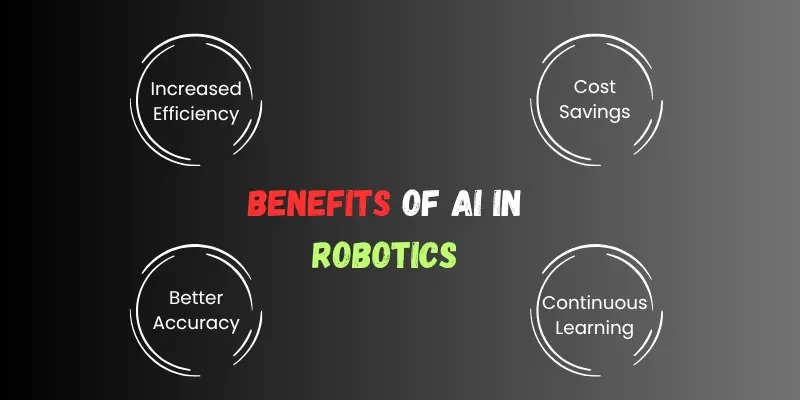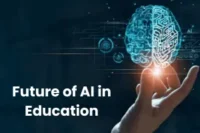Role of AI in Robotics: How Smart Robots Make Life Easier
Published: 21 Oct 2025
The world of technology is moving rapidly, and one of the most significant game changers is the role of AI in robotics. Robots are no longer basic devices that solely execute predefined orders. They can now think, learn, and make decisions owing to artificial intelligence (AI).
AI enables robots to analyze data, comprehend their environment, and function autonomously. This makes them smarter and more useful in fields like as healthcare, industry, education, and even our own homes.
If you want to understand how AI works in other fields too, check out our guide on the Role of AI in Cybersecurity It shows how AI protects digital systems from modern threats.
In this article, we will explain the role of artificial intelligence in robotics, how it works, where it is utilized, its benefits, problems, and what the future holds, all in simple terms and with real-world examples.
The Role of AI in Robotics
The role of AI in robotics is to make robots smart, self-sufficient, and capable of performing complicated tasks. Previously, robots could only execute basic orders written by humans. They were unable to make independent judgments or deal with unfamiliar situations. Today, Artificial Intelligence (AI) is changing everything.
AI works like a brain for robots. It helps them:
- Understand the world around them through sensors and computer vision.
- Make smart decisions using collected data.
- Learn from experience with machine learning.
- Communicate with humans using natural language processing (NLP).
For example:
- Self-driving cars use AI to detect traffic signs and avoid accidents.
- Healthcare robots assist doctors in surgeries by analyzing data in real time.
- Factory robots use AI to check product quality and increase efficiency.
In simple words, AI turns robots from simple machines into intelligent partners that work in hospitals, factories, homes, and even space.
Main AI Technologies Used in Robotics
Artificial intelligence has drastically transformed the way robots operate. Today, robots are more than just devices that obey instructions. They can reason, study, and make judgments. This is made feasible by the application of artificial intelligence technology in robots. Let’s have a look at the important ones:
1. Machine Learning (ML)
Machine Learning helps robots learn from data. For example, a robot in a factory can improve its speed by analyzing past work. It does not need new programming every time. ML allows robots to become smarter over time.
2. Computer Vision
This technology enables robots to perceive and interpret items. Robots employ cameras and sensors to identify shapes, faces, and objects. For example, delivery robots utilize computer vision to avoid roadside obstructions.
3. Natural Language Processing (NLP)
NLP allows robots to understand and respond to human language. This is the technology behind voice assistants such as Alexa or Siri. Robots in customer service use NLP to answer questions naturally.
4. Neural Networks
Neural networks enable robots to process massive volumes of data. They operate similarly to the human brain. Advanced robots employ this technology to make decisions and recognize patterns.
5. Reinforcement Learning
This is a special type of machine learning where robots learn by trial and error. For example, a robot learns how to walk by practicing and improving every time it fails.
Real-World Examples
AI is changing how robots work in real life. Let’s look at some real-world examples where AI in robotics is making a big difference:
1. Self-Driving Cars
Companies such as Tesla and Waymo utilize AI-powered robots to drive vehicles. These cars utilize sensors, cameras, and artificial intelligence algorithms to analyze the route, recognize objects, and make safe judgments in real time.
2. Healthcare Robots
Doctors can conduct surgery with more accuracy thanks to robots like the da Vinci Surgical System. AI enables these robots to learn moves and aid surgeons during intricate procedures.
3. Industrial Robots
Factories use AI robots for tasks like welding, assembling, and packing. For example, car companies like BMW and Toyota use AI robots to build cars faster and with fewer errors.
4. Delivery Robots
Companies such as Amazon and Starship Technologies utilize AI robots to deliver items. These robots plan the optimal path and avoid obstructions as they approach your door.
5. Humanoid Robots
AI allows robots like Sophia and Ameca to communicate, interpret emotions, and interact with people. They’re commonly utilized for customer service and research.

Benefits of AI in Robotics
AI gives robots the power to think, learn, and make smart decisions. Here are the main benefits:
- Increased Efficiency: AI robots work faster than humans. They can do repetitive tasks without getting tired, which saves time in industries like manufacturing.
- Better Accuracy: AI reduces mistakes. Robots can perform delicate tasks, like surgeries, with high precision.
- Cost Savings: Using AI robots can result in cheaper long-term expenses. They decrease the need for human labor and work around the clock for no additional cost.
- Safer Work Environment: Robots can work in dangerous areas, like chemical factories or disaster zones. This keeps humans safe from harm.
- Smart Decision-Making: AI enables robots to make speedy judgments based on real-time data. Self-driving automobiles, for example, make rapid decisions on whether to stop or turn.
- Continuous Learning: With AI, robots learn from experience. They improve over time and become smarter without human help.
If you’re curious about the overall advantages and drawbacks of AI, don’t miss our article on the Pros and Cons of AI. It explains both sides clearly with real-life examples.
Challenges of AI in Robotics
AI in robotics is powerful, but it comes with some big challenges:
- High Cost: Building and maintaining AI-powered robots is expensive. Small businesses often can’t afford them.
- Complex Technology: AI systems require powerful software and hardware. Designing and programming them requires a great deal of skill and effort.
- Job Loss Concerns: Many people worry that robots will take over human jobs. This creates fear and resistance to using AI.
- Data Dependency: AI robots require a lot of data to function properly. They may make poor judgments in the absence of proper facts.
- Security Risks: AI robots can be hacked. This can cause serious problems in industries and even harm people.
- Lack of Human Emotions: Robots can’t understand feelings like humans do. This makes them less effective in jobs that need empathy, like healthcare.
Future Trends of AI in Robotics
The future of AI in robotics looks exciting. Here are some trends to watch:
- Smarter Robots: Robots will become more intelligent. They will learn from experience and make better decisions without human help.
- Human-Robot Collaboration: Robots will work side by side with humans in factories, hospitals, and offices. They will help people, not replace them.
- Healthcare Robots: AI robots will play an important role in healthcare. They will assist with operations, patient care, and mental health assistance.
- Autonomous Vehicles: Self-driving cars and delivery robots will become more common. They will use AI to navigate roads safely.
- Service Robots at Home: Robots for cleaning, cooking, and home security will become more intelligent and affordable. More houses will start utilizing them.
- Ethical AI and Safety: As robots become smarter, rules and laws will focus on keeping them safe and fair for everyone.
Conclusion
AI is transforming the field of robotics in amazing ways. Robots are growing smarter, quicker, and more useful in our everyday lives. From industries to hospitals, they make work easier and safer. But we still have to deal with issues like cost, safety, and ethics. Smarter robots and new technology are on the way, making the future appear promising.
Are you ready for a world in which machines and humans collaborate? Because the future isn’t far away!
Frequently Asked Questions [FAQs]
Have questions about AI in robotics? Here are some common questions and answers to help you understand the topic better:
AI enables robots to think and make intelligent judgments. It enables them to learn from data, identify things, and complete jobs without full human supervision.
AI makes robots smarter. They can better perceive their environment, prepare ahead of time, and accomplish complicated jobs with speed and accuracy.
The main benefits are better efficiency, accuracy, and safety. Robots can do dangerous, boring, or repetitive jobs so humans can focus on important work.
In the future, robots will become more intelligent and independent. They may work with humans in homes, offices, and many industries.

- Be Respectful
- Stay Relevant
- Stay Positive
- True Feedback
- Encourage Discussion
- Avoid Spamming
- No Fake News
- Don't Copy-Paste
- No Personal Attacks

- Be Respectful
- Stay Relevant
- Stay Positive
- True Feedback
- Encourage Discussion
- Avoid Spamming
- No Fake News
- Don't Copy-Paste
- No Personal Attacks





